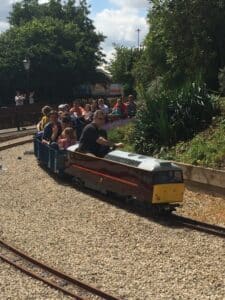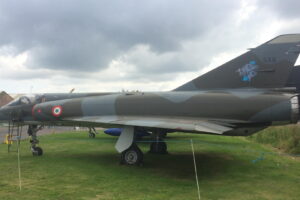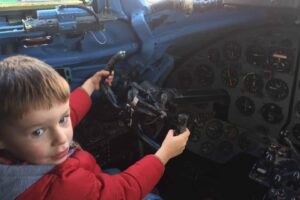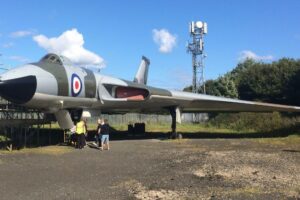
National Railway Museum - Replica Rocket

National Railway Museum - Eurostar

National Railway Museum - Harry Potter Sign

National Railway Museum - Livingston Thompson

National Railway Museum - Mallard Cab

National Railway Museum - The Mallard

National Railway Museum - Model Railway

National Railway Museum - Shinkansen Japanese Bullet Train

National Railway Museum - Signal Exhibition

National Railway Museum - The Great Hall

National Railway Museum - The Stores
The National Railway Museum is home to over 300 years of history and over a million wonderful objects. Discover how Railways changed the World. Marvel at railway legends including Mallard which holds the world steam record speed of 126 mph. Watch engineering work in progress in the Workshop, browse the object-filled Warehouse, and let off steam in the outdoor play area.
History of The National Railway Museum
Before the National Railway Museum was in existence, the Science Museum in London started its collection of railway artefacts by acquiring The Rocket in 1862.
Think Big at The National Railway Museum
Get up close and personal with the technology that shaped the modern world. Meet legends of the railway, including the world’s fastest steam locomotive and Queen Victoria’s luxurious personal carriages. Ride the miniature railway, join in with live engineering shows and spark your imagination with free talks and tours from the resident experts.
The Early 1900’s
From the late nineteenth century, railway companies began preserving their past. The most prolific being the London and North Eastern Railway (LNER), which opened a public museum in York dedicated to railways in 1927. During the 1930s, the Great Western Railway (GWR), the London, Midland and Scottish Railway (LMS), the London and North Eastern Railway (LNER) and the Southern Railway (SR) had all collected significant quantities of railway related material. It wasn’t until 1948 when nationalisation of the railways took place that these collections were all brought together.
Post-nationalisation
In 1951, a ‘curator of historical relics’ of the nationalised transport industries was appointed. A collecting policy could now be implemented to increase the nation’s collection of railway artefacts. Anything fitting the requirements of the policy, and more importantly being relevant to telling the story of the train could be listed for the collection. As well as the existing York Railway Museum at Queen Street, British Railways opened the Museum of British Transport in Clapham, South London and worked with Swindon Council to open a museum there.
The Formation of The National Railway Museum
The 1968 Transport Act encouraged British Rail to work with the Science Museum to develop a National Railway Museum to house the massive and ever-expanding collection. In 1975 the National Railway Museum opened at Leeman Road in York. The huge former steam locomotive depot, only 700m from York Minster was an ideal site for a National Railway Museum. Following its conversion and opening as the very first National Museum outside London, the museum was an immediate success with the public.
Expansion of The National Railway Museum
Since 1975 the Museum has been extended on a number of occasions. In 1990, the museum was nearly doubled in size when the Station Hall opened across Leeman Road in York’s former railway goods depot. This development won the Museum of the Year Award in 1990. The former diesel depot adjacent to the Great Hall was added as a store. In 1999 this was rebuilt to become The Works, providing public access to the Museum’s collections stores and workshops and a viewing gallery overlooking York Railway Station. The success of The Works led, in part to the Museum gaining the European Museum of the Year award in 2001.
Locomotion: The National Railway Museum at Shildon
In 2004 a new museum, Locomotion: The National Railway Museum at Shildon, County Durham, opened its doors to the public. This joint venture with the local authority enabled more of the National Railway Museums collections to be housed properly and enjoyed by the public. This new visitor attraction is also helping to develop tourism in Shildon, the birthplace of the modern railway.
Recent Additions
One of the latest additions to The National Railway Museum is Search Engine, a £4 million archive and research centre. Search Engine allows visitors to view and see otherwise previously unseen artwork, papers, reports, photographs, and small artefacts. This new attraction offers access to the museum’s vast archive collection. One of the largest and richest collections of railway related material in the world.
The Worlds Most Popular Railway Museum
Today The National Railway Museum is one of Britain’s busiest museums and is perhaps the most popular railway museum in the world. It serves a diverse audience at its two sites and elsewhere through its network of partnerships with museums and heritage railways across the UK.
The Future of The Railway Museum
The National Railway Museum in York has revealed details about a planned £50m, seven-year upgrade. The renovations would allow the National Railway Museum to re-display over 12,000 objects and bring 1,000 more into a public display for the first time in a reimagined Open Store.
The £50 Million project named York Central would represent the biggest investment in the National Railway Museum since its opening in 1975.
National Railway Museum Collection
The National Railway Museum collection has been built up over the past 80 years. It has over 100 locomotives and nearly 200 other items of rolling stock, telling the story of the railway from the early 19th century to today. There is a large collection of Trains and associated railway artefacts at The National Railway Museum in York. Below we have listed a small selection of the highlights.
The Mallard
Designed by Sir Nigel Gresley, on the 3rd July 1938, the A4 class locomotive Mallard raced down Stoke Bank at 126mph to set a new steam locomotive world speed record. That record still stands today. At The National Railway Museum, you can learn more about the amazing achievement and see the World famous train in person.
Replica Rocket
George Stephenson and his son Robert were amongst the very first locomotive engineers. They believed passionately about steam and used a pioneering boiler design to build Stephenson’s Rocket. The famous locomotive main features were:
* A multi-tubular boiler, to improve the heat transfer from the firebox gases into the boiler water
* The ‘blast pipe’ which used the steam exhaust to improve the air draught through the firebox
* Direct coupling, by connecting rods, from the pistons to the driving wheels.
Eurostar
Donated by Eurostar. The power car is the centre of an exhibition that acknowledges the historic role the train has served in connecting the UK with the rest of mainland Europe. A marvel of modern engineering, the Eurostar power car has average operating speeds of 186 mph (300 kph). The Eurostar is part of the same series as the train that holds the current UK rail speed record of over 208mph.
Shinkansen Japanese Bullet Train
Japan’s high-speed railway revolution resulted in the remarkable Bullet Train. The speedy bullet train would whisk passengers along at speeds of just over 130mph and was the forerunner of high-speed trains everywhere.
When the Shinkansen (which translates as ‘new line’) opened in 1964 it was a radical re-imagining of the passenger railway. The Shinkansen or ‘Bullet Train’ ran on a specially built, passenger-only line with in-cab signalling. Within seven years these trains tripled the traffic on the lines on which they ran. The train on display at The National Railway Museum is the only Shin-Kansen outside of Japan.
Duchess of Hamilton
The Duchess of Hamilton was saved from the scrapyard by Billy Butlin in his efforts to secure it as a playground exhibit at his Butlins holiday camps. The streamlined Duchess is a stunning piece of 1938-built Art Deco opulence that wowed design critics on both sides of the Atlantic. It was a modern machine for a modern age.
Class 31
The Class 31’s diesel engine was developed from engines used in ships. The locomotive was designed to replace steam as part of the British Railways Modernisation Plan of 1955. Examples of this type of diesel locomotive are still in service for Network Rail.
Royal Carriages
Peek into the past and imagine what it was like to tour Britain as part of the Royal family. The collection includes:
* Queen Victoria’s ‘Palace on Wheels’ is the most famous and popular of the royal carriages and is one of the several saloons made for the Queen during her reign. It is the only surviving example and was her undoubted favourite. It became part of the collection in November 2003, 103 years after it was last used by Queen Victoria.
* Queen Adelaide’s saloon, the oldest preserved carriage in Europe.
* King Edward VII’s royal carriage. Built by the London & North Western Railway in 1902. It was the principal royal train used for travel to Scotland.
* The most modern (and considerably less extravagant) royal train is the Royal Saloon built for King George VI and Queen Elizabeth (Queen Mother) in 1941. Built during the Second World War, its carriages were designed to give maximum protection to its royal inhabitants.
Other Attractions
In addition to the locomotives on display, there are a number of other great attractions at The National Railway Museum. Additional Charges may apply.

York Miniature Railway Ride
Journey past gigantic railway objects and through the ever-changing landscapes of the South Yard on board the miniature railway.
Model Railway
The ‘O’ gauge model railway can be found in Great Hall adjacent to the Shinkansen bullet train. It was first built in 1983 and has had two significant upgrades in its life, including the installation of a wider and more accessible viewing platform for wheelchairs users.
Little Play Station
Join in with your children whilst taking in the sights of our magnificent locomotives. Younger visitors can explore, build, move, pretend and play with lots of interactive activities including building their own mini Stephenson’s Rocket, selling tickets in the little Railway Station and playing with huge toy railways.
Outdoor Play Area
Located adjacent to the Miniature Railway Ride is the Outdoor Play Area.

Inspection Pit
Get an insight into what a train looks like from below in the inspection pit.
Eating and Drinking
The National Railway Museum has a wide range of refreshment stops and cafes to choose from. Options range from the splendid comfort of a Victorian-inspired ‘dining car’ to ice creams at the quirky outdoor container café.
The Dining Car Restaurant
Dine in a Victorian-inspired ‘dining car’, or relax in a 1920s lounge. The Dining Car Restaurant is nestled between the stunning royal carriages in the Station Hall. This restaurant creates a unique dining experience for either a leisurely lunch or a chance to enjoy home-baked cakes and fresh teas and coffees.
The Mallard Cafe
The Mallard Cafe is located in The Great Hall. Take a seat amongst the magnificent locomotives including Mallard itself. Indulge yourself and choose something from the delicious menu filled with locally sourced hot and cold deli food and bakery treats.
The Courtyard
Part of the courtyard linking the two main buildings has been transformed into a quirky outdoor container cafe. Inspired by the extraordinary shipping container cafes around the world, the unique cafe serves pizzas, ice cream, hot and cold drinks and is ideal for eating in the sunshine.
Countess of York
Travel back in time to the era of high-class railway dining with a luxury afternoon tea experience aboard the beautifully restored rail carriage, the Countess of York. The sophisticated afternoon tea menu features delicious sandwiches, homemade cakes and fancies and a wide selection of loose leaf teas, with ingredients changing seasonally. The carriage is also available to hire exclusively for that extra special private or corporate event.
The Science Museum Group
The National Railway Museum is part of The Science Museum Group – a family of museums. The Science Museum Group is devoted to the history and contemporary practice of science, medicine, technology, industry and media. Its collections, in the fields of science, technology, engineering, medicine, design and enterprise, transport and media, are the largest, most comprehensive and most significant in their field anywhere in the world.
The Science Museum Group incorporates the following museums and collections:
* The Science Museum
* The Science Museum Library
* The Wellcome collections of the history of medicine
* The National Railway Museum
* The National Science and Media Museum
* Locomotion
* The Museum of Science and Industry
* Concorde 002
Admission Prices and Offers
Entry to The National Railway Museum is free, but donations are welcome. Visitors under 12 years of age must be accompanied, at all times, by an adult.
Travelling to The National Railway Museum
York City centre is encompassed by its ancient walls and is accessible on foot. It’s a 10-minute walk to the Museum from the centre of town, and the route is well signposted. But for a quicker, more convenient route from the city centre, you can also catch the road train. Travel straight to the Museum’s door from Duncombe Place (next to York Minster).
Travelling by Train
The National Railway Museum is only a few minutes walk from York Railway Station and the route is well signposted. There is also a direct route to the Museum via the station footbridge (not suitable for wheelchairs or pushchairs). York Railway Station has great links to major cities across the UK. See the Raileasy website for details.
Travelling by Coach
Visit National Holidays if you want to travel by coach to York.
Nearby Accommodation
There are lots of places to stay in and around the city of York. Find hotel accommodation at Hotels.com or Travelodge and Britannia Hotels are always a good option for budget hotel accommodation.
If you prefer self-catering, check out some of the lovely places to stay on the outskirts of the City of York on Snaptrip.
Attractions Near Me Offers
For the best deals and Discount Days Out visit our Offers page Attractions Near Me
Also like our Facebook page for notification of any new offers Facebook.com/AttractionsNearMe
Sorry, no records were found. Please adjust your search criteria and try again.
Sorry, unable to load the Maps API.














